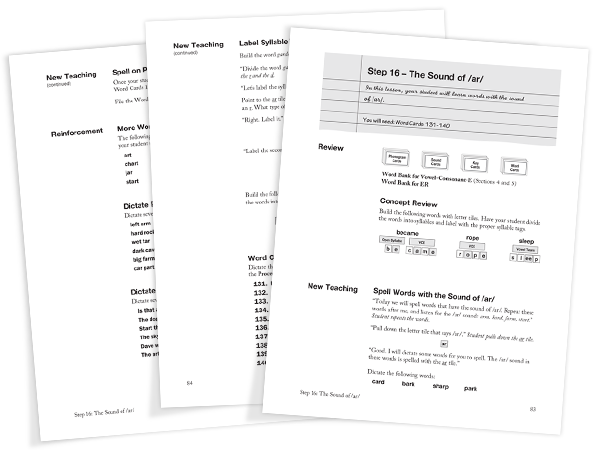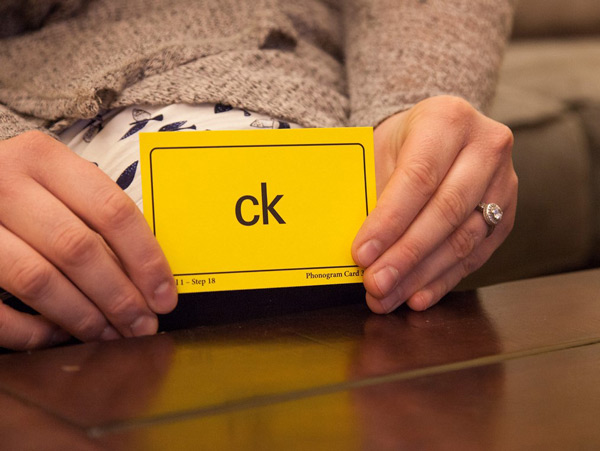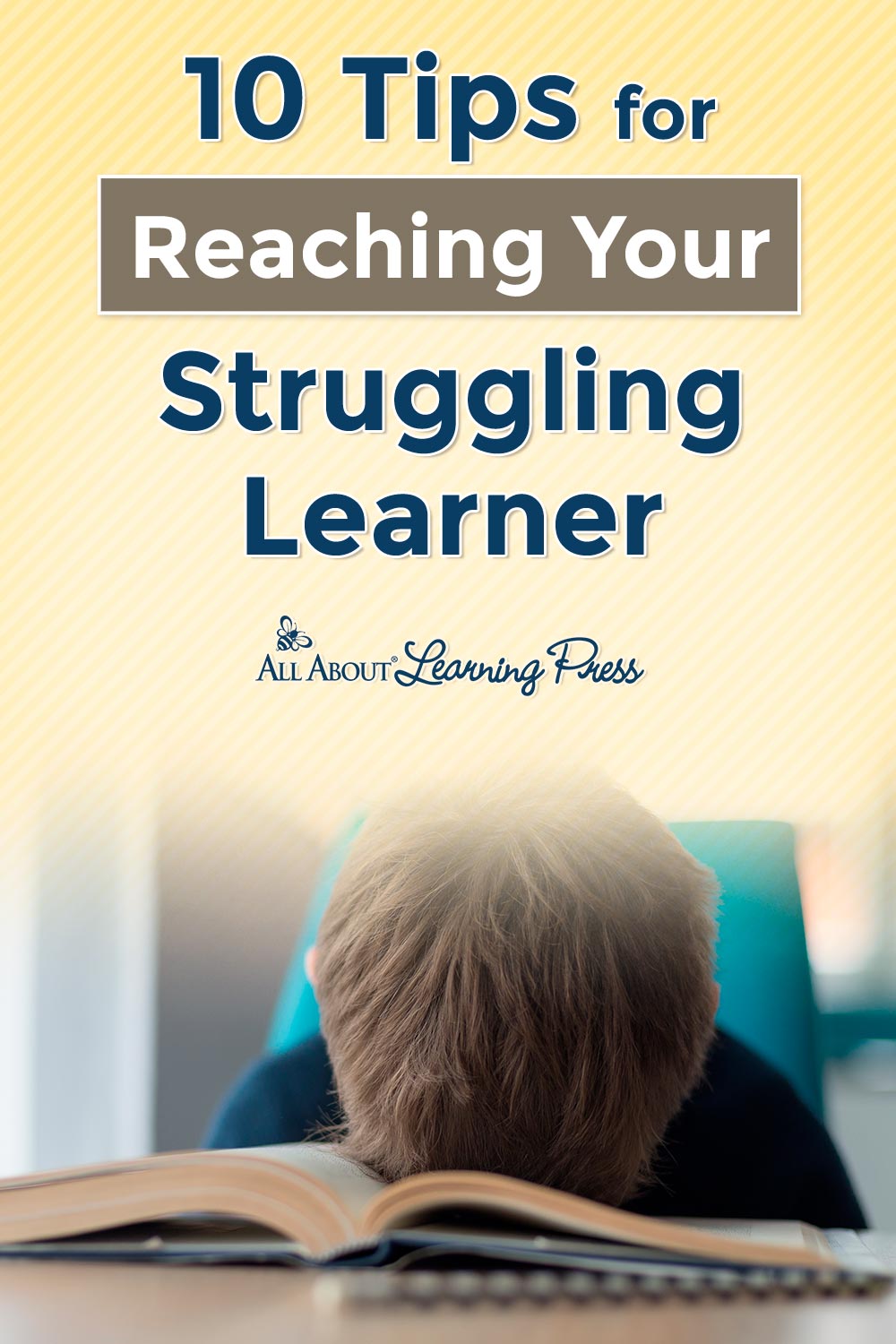How to Teach Slow Learners to Read
x Tips for Reaching Your Struggling Learner

When your child is a struggling learner, information technology can be scary.
My son struggled with reading and spelling, then I know firsthand what that fear feels similar.
You feel responsible for making sure your child grows upwardly being able to read and spell proficiently, because you lot know that your child'south future options will be limited without those essential skills.
You don't want to see your struggling learner blocked from reaching his full personal potential, and you would practise almost annihilation to assistance him overcome his struggles.
What Is a Struggling Learner?
A struggling learner has to piece of work harder than others around him in lodge to attain the same chore or acquire the aforementioned thing. The kid may be a year or more behind grade level in ane area or in all subjects.
There are many possible reasons for the kid's struggles. He may have concrete disabilities that affect sight, hearing, mobility, or coordination. Or he may have learning differences such every bit dyslexia, dysgraphia, or auditory processing disorder. Interestingly, a struggling learner may be gifted in some areas, such every bit a child who is astonishing with math just does not read.
One very mutual reason for learning struggles is that the child has not yet been taught in a fashion that works for him. For example, he may need the structure and logic of a phonetic approach to reading, but he is being taught with a whole language approach.

10 Tips for Educational activity a Struggling Learner
There are very specific teaching methods that you tin use to help your struggling learner succeed. I of the most of import things you will want to practice is to utilise curriculum and didactics strategies that can be customized to encounter his needs.
Even if other methods have failed to work for your child, the ten tips that follow volition help you reach your struggling learner.
-
Teach Through Directly Instruction
Straight instruction is a proven method in which the child is taught exactly what he needs to larn. With direct education, the information is presented very clearly through well-tested materials that rule out the possibility of misinterpretation and confusion. And your kid is shown exactly how to employ the information, also. The explicit teaching of language rules and patterns means that your child doesn't have to guess or struggle to figure out how to read or spell a difficult word.

-
Choose an Incremental Approach to Lessons
Incremental ways that lessons start with the about bones skills and gradually build up to more than advanced skills. Each lesson builds upon previously mastered material, and gradually increases in difficulty.
Incremental educational activity provides a "no gaps approach" that allows your child to acquire one new slice of noesis at a fourth dimension in a well-thought out, logical sequence. With this approach, kids can successfully climb to the top of the learning ladder—pace by footstep past step—and reap the rewards of mastery in reading and spelling without all the struggles forth the way.
-
Sympathize the Importance of Multisensory Education
Multisensory learning happens when sight, sound, and bear on are used to learn new information. Children acquire best when they tin utilize all their senses. When children can see a concept as it is explained, hear nigh it, and then do it with hands-on activities, it is easier for them to learn and retain the new data.
In a multisensory spelling lesson, for example, your child can see a new give-and-take spelled out with letter tiles, hear and see a demonstration of a related spelling rule, try out the spelling rule for himself by manipulating the alphabetic character tiles, and say each audio of the new word as he writes it out on paper. This combination of activities uses multiple pathways to the brain.

-
Requite Your Child an Advantage by Teaching the 72 Basic Phonograms
Kids who struggle with reading and spelling often have a misconception: they think that the key to reading and spelling success is memorizing strings of letters. Merely the fact is that it's very difficult for children to memorize words this way. They oft just become frustrated and give up.
There'south a better way. Teaching phonograms helps kids run across spelling as a achievable task. A phonogram is a letter or letter of the alphabet combination that represents a sound. For example, CK is a phonogram that says /k/ as in clock; OY is a phonogram that says /oi/ as in oyster.

Each sound in a word can be represented by a phonogram. If your child learns the phonograms and which sounds they correspond, reading or spelling the word will go then much easier. If he knows that the sound of /j/ at the end of a short-vowel word is spelled with DGE, the word span becomes simple to read and spell.
-
Teach Just One New Concept at a Fourth dimension
When you dump besides much information into your child'southward mental "funnel," your child's retention tin can only nourish to a certain corporeality of the new information. Educational activity 1 concept at a time respects the limitations of your kid's short-term retentiveness, and allows concepts and skills to be more easily stored in the long-term memory. And that means significant amounts of meaningful learning can occur.
-
Teach Reliable Rules
Children are actually helped by knowing a few reliable spelling rules. For case, knowing the rules well-nigh doubling consonants at the end of words can aid them spell words like floss, sniff, and fill up. When your kid learns trustworthy spelling rules—similar the Floss Rule—he'll have some guidelines to help him brand the correct letter choices.
-
Teach Reading and Spelling Separately
On the surface it may seem to make sense to teach reading and spelling together. But in reality, although they are similar, reading and spelling require different teaching techniques and a dissimilar schedule. Reading is easier than spelling, and teaching these subjects separately is much more effective for well-nigh kids. Separating these subjects allows kids to progress as quickly as possible through reading while taking as much time as needed in guild to become an effective speller.
-
Make Review a Priority
Consistent review is the key to getting spelling facts and spelling words to "stick." Teaching something once or twice does non mean your child has actually mastered it. Mastery takes time—and do.
Review doesn't take to be boring, either. Accept your child practice spelling concepts with letter tiles and flashcards and through dictation. Utilize a multifariousness of techniques to ensure that your kid retains what you are teaching.

-
Keep Lessons Short but Frequent
Brusque, frequent lessons are much better than longer, sporadic lessons. In a brusque lesson, your child'due south attention is less probable to wander, and you'll find that you tin really attain more. Keep the lessons upbeat and fast-paced, and use pedagogy tools and activities that appoint the child's interests.
Start with xv-20 minutes per solar day, five days a week. You can accommodate the length of the lessons up or down co-ordinate to your individual kid's attention span and specific needs. (Here are guidelines for lesson length for pedagogy reading and teaching spelling.)
-
And Finally, Recognize the Power of Encouraging Words
In the ups and downs of the daily grind, we sometimes get and so focused on didactics and "improving" our kids that we forget to encourage them. The first 9 tips are all congenital into the All About Reading and All About Spelling programs, but putting the power of encouraging words to work in your homeschool is all up to you!
For many people, using encouraging words doesn't e'er come naturally, so we created a way to help moms and dads remember how important information technology is. Be sure to visit our blog post on 7 Ways to Be the Teacher Your Kid Needs and download the complimentary affiche as a reminder.
Teaching a struggling learner tin can be difficult, but the tips above tin help make it a lot easier—and I know that from experience. Only accept it i day at a time. Before yous know information technology, your struggling learner volition be doing things in life that you never dreamed were possible!
Is your child struggling in reading or spelling? We're here to help! Postal service in the comments below, requite us a call (715-477-1976), or send united states of america an electronic mail ([electronic mail protected]).
goodwinbispecephe.blogspot.com
Source: https://blog.allaboutlearningpress.com/struggling-learner/

0 Response to "How to Teach Slow Learners to Read"
إرسال تعليق